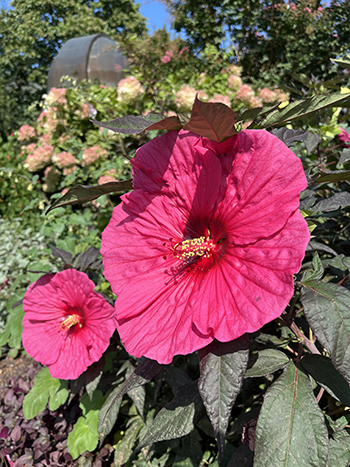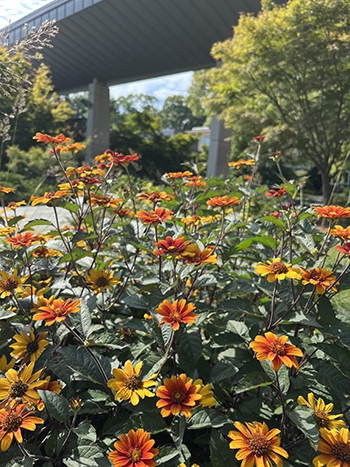
Plants of the Week: September 9
Guest Author: Seamus Lewin, 2024 – 2025 Public Horticulture Intern

Magnolia grandiflora ‘Victoria’ – southern magnolia
Nestled between the lower Biostream and Public Safety you will find a lovely collection of some of the most recognizable trees on the east coast. The southern magnolia is distinct for having foliage with a glossy evergreen topside, and fuzzy red underside.
In early to mid summer, these trees bear large white flowers with a mild lemon scent, but at this time of year the attraction is in their fruit. The large oval-shaped fruit of the southern magnolia range in color from white to dark pink. However, they often end up having a gradient of the two, the result of which is arguably just as attractive as the flowers of this tree.
While this tree is generally more hardy in USDA zones 7-9, the featured cultivar ‘Victoria’ is a selection that is known for being cold hardy even in the Pacific Northwest. This cultivar of southern magnolia does very well in the Mid-Atlantic region, as a result.

Hibiscus ‘Candy Crush’ – hibiscus
If you take a stroll through the Terry Shane Teaching Garden, one of the more striking flowers you will find in bloom right now is the Hibiscus ‘Candy Crush’. One of the more defining features of most hibiscus are their 5-petaled flowers. The bright bubblegum pink petals of this cultivar overlap, forming a large flower that is both wonderfully circular and symmetrical.
Hibiscus ‘Candy Crush’ is upright and has flowers that offer a stunning garden presence. This plant can be used in place of a shrub to structure a sun garden, and because it blooms late and grows quickly, it is great for brightening up a garden at the end of a season. Additionally, you can use this plant in pollinator gardens as it is irresistible to hummingbirds and butterflies.

Heliopsis helianthoides var. scabra ‘Bleeding Hearts’ – false sunflower
At the entrance to the Harry Wood Garden, you will stumble upon a bed of orange flowers that, aside from not being yellow, look almost like small sunflowers. You would not be alone in thinking that, as these flowers are Heliopsis helianthoides var. scabra ‘Bleeding Hearts’, also known as false sunflower.
This particular strain is prized for being the first Heliopsis without any trace of yellow on its leaves. Instead its leaves are variegated and range from an intense light orange to a darker orange-red.
These plants are long-blooming, and can be seen all the way from the middle of summer to the middle of the fall. They serve best at the back of a flower border, and you should consider planting some if you want to attract pollinators like butterflies or repel rabbits and deer. Because they make a great cut flower, you will also find them in many of the flower arrangements around campus including Wister Center, Parrish Hall, and the Inn at Swarthmore.





No Comments